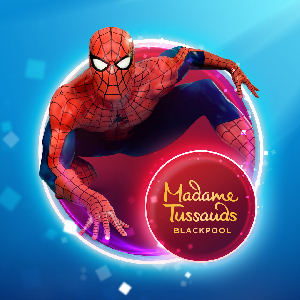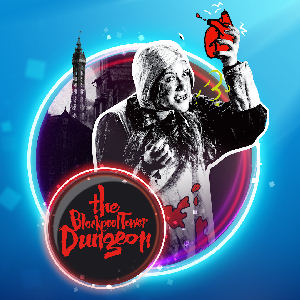30th August 2024 - 5th January 2025
Construction of the New Illuminations
How are the illuminations features created?
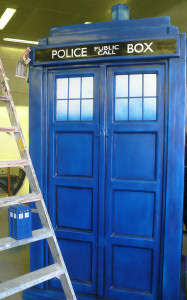
Model and Full Size Tardis
On the 10th July Blackpool Illuminations Department on Rigby Road opened its doors to visitors. This was a wonderful experience as we not only saw the new Illuminations under construction but our guide, Richard, was great at not only showing us the process but also describing what goes on on a day by day basis at the works.
I will attempt to describe how the illuminations, each one called a feature, are created from the very start. I hope I can remember what I was told.
The start of the process is the design team decide on either a theme, for a new section or just a few new pieces. They then either give the construction crew a sketch, drawing or even a model to build from. For example for the new Dr Who features the team were given small models to scale from and the BBC provided detailed images for the pictorial illuminations.
Once the scale drawings have been produced a full size replica is produced in polystyrene. This is all done by hand using a hot wire cutter then lots of manual shaping with knives and sand paper.
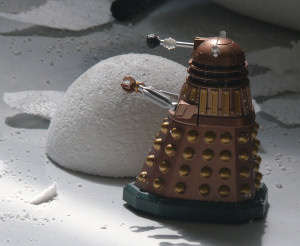
A model dalek and a full
size polystyrene sphere
Once the replica is produced it is covered in plaster, the same stuff that is used to plaster walls in your house. This is because the finished items will be made of fibre glass, and fibre glass melts polystyrene.
This replica is then used to make a mould in fibre glass, the mould is then released from the replica. This mould is cleaned up and any imperfections corrected. The mould can then be used to make lots and lots of exact duplicates.
Laying up the fibre glass into the moulds
The mould is then layed flat and coated in a releasing agent. The fibre glass matting is layered onto the mould and resin is worked into it. This is a messy job and takes quite a bit of skill to avoid air bubbles and make sure the thickness is consistent. As any flaws will show up in the finished feature.
Once the fibre glass is dried, the piece is carefully removed from the mould. It is then cleaned and trimmed ready for assembly. To produce a tardis approximately seven pieces are required, these are bonded together again using fibre glass and resin.
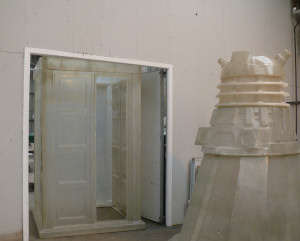
Tardis and Dalek before paint
Once the item is constructed it still has a long way to go. Next is the metal support frame that not only gives it rigidity but also enables it to be fixed in the desired position, be that on a lamp post on an a tableaux.
Now the painting begins. First a coat of white is applied using a small spray gun similar to a car body repair garage would use, but the Illuminations Department use water based paints as they are both more environmentally friendlier but also better for the artists health.
After the white coat the base colour of the feature is added, in the tardis case the blue. Then the details are added by the artists, such as the black outlining on the tardis. Once the painting is complete the whole feature is covered in a clear weather proof varnish to protect it from the weather as some of the illuminations spend all of their time outdoors.
The final part of the constructing process is the lighting or should I say illuminating of the feature. This is not just a case of sticking a few lamps inside, many factors have to be considered. The lamps are mainly 12 or 24v ac as this makes maintenance safer for the staff. Most if not all the lamps are now produced in China, this is due to the relatively small number of lamps required (there are over a million lamps) Blackpool Illuminations tried to source from UK suppliers but they would not manufacture the lamps. By continuously pushing the bounds of lighting technology Blackpool again became a first. In 2002 Blackpool Illuminations featured LED floods, these are Light Emitting Diodes, similar to the red light on your TV, but instead of a single LED each flood has a number of LED's that are hyper bright and can change colour. Also in 2002 due to improved technology the Illuminations used 11% less electricity and as of 2004 Wind power is assisting to power the Illuminations, and during 2007-08 three additional turbines were installed next to the Water Park at South Shore. Once the lighting has been installed and tested the feature is ready to go on public display.
Venus Reborn Construction
Venus Reborn
Water Tank
Venus Reborn
First Signs of Construction
For 2008 Laurence Llewelyn-Bowen has designed a stand alone tableaux which will be positioned on the East side of the promenade opposite the water park in Flagstaff Gardens. Design sketches and a pictorial view can be seen on the Designers page.
Construction started in July, with the installation of a new electrical supply, water supply, post holes, and a fully cleaned drain. Most of which was fairly hidden as it was just a few galvanized boxes next to the wall in Flagstaff gardens, the post holes had covers on. So unless you knew that an Illuminations feature was in the pipeline you would be non the wiser.
By the 13th August the first signs of the Venus Reborn feature had emerged.
Next the massive water tank has been installed in front of the posts. This water tank could, at a guess hold 4,500 liters the equivalent of 1000 gallons. This is going to be one spectacular display, it is rumored to create a 15 minute show that will entertain the passing public. But remember that if you just drive the lights you wont see the full effect.
Laurence Discusses
the Illuminations Feature
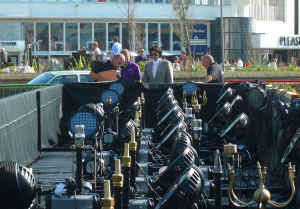
Venus Reborn
The Inner Workings
Progress on Venus Reborn has been very swift, the tank now has a liner, 30 pumps, and lots of colour flood lights. On the 21st August, just 8 days before the switch on the Flagstaff Gardens site received a very special visitor. It was the artist responsible for Venus Reborn Laurence Llewelyn-Bowen!
The team responsible for the engineering design and construction of the Venus Reborn feature chat to Laurence and explain how it all works.







